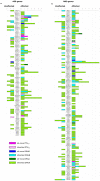This is a preprint.
Whole genome analysis of rare deleterious variants adds further evidence to BRSK2 and other risk genes in Autism Spectrum Disorder
- PMID: 37961520
- PMCID: PMC10635364
- DOI: 10.21203/rs.3.rs-3468592/v1
Whole genome analysis of rare deleterious variants adds further evidence to BRSK2 and other risk genes in Autism Spectrum Disorder
Update in
-
Genomic analysis of 116 autism families strengthens known risk genes and highlights promising candidates.NPJ Genom Med. 2024 Mar 22;9(1):21. doi: 10.1038/s41525-024-00411-1. NPJ Genom Med. 2024. PMID: 38519481 Free PMC article.
Abstract
Autism spectrum disorder (ASD) is a complex neurodevelopmental condition with a strong genetic component in which rare variants contribute significantly to risk. We have performed whole genome and/or exome sequencing (WGS and WES) and SNP-array analysis to identify both rare sequence and copy number variants (SNVs and CNVs) in 435 individuals from 116 ASD families. We identified 37 rare potentially damaging de novo SNVs (pdSNVs) in cases (n = 144). Interestingly, two of them (one stop-gain and one missense variant) occurred in the same gene, BRSK2. Moreover, the identification of 9 severe de novo pdSNVs in genes not previously implicated in ASD (RASAL2, RAP1A, IRX5, SLC9A1, AGPAT3, MGAT3, RAB8B, MGAT5B, YME1L1), highlighted novel candidates. Potentially damaging CNVs (pdCNVs) provided support to the involvement of inherited variants in PHF3, NEGR1, TIAM1 and HOMER1 in neurodevelopmental disorders (NDD), although mostly acting as susceptibility factors with incomplete penetrance. Interpretation of identified pdSNVs/pdCNVs according to the ACMG guidelines led to a molecular diagnosis in 19/144 cases, but this figure represents a lower limit and is expected to increase thanks to further clarification of the role of likely pathogenic variants in new ASD/NDD candidates. In conclusion, our study strengthens the role of BRSK2 and other neurodevelopmental genes in ASD risk, highlights novel candidates and contributes to characterize the allelic diversity, mode of inheritance and phenotypic impact of de novo and inherited risk variants in ASD/NDD genes.
Conflict of interest statement
Conflict of Interest MCZ declares to be a shareholder in Abbott, Abbvie, BMS, Merck, Pfizer, Thermo Fisher, and J&J.
Figures




Similar articles
-
Genomic analysis of 116 autism families strengthens known risk genes and highlights promising candidates.NPJ Genom Med. 2024 Mar 22;9(1):21. doi: 10.1038/s41525-024-00411-1. NPJ Genom Med. 2024. PMID: 38519481 Free PMC article.
-
Phenotypic and genetic analysis of children with unexplained neurodevelopmental delay and neurodevelopmental comorbidities in a Chinese cohort using trio-based whole-exome sequencing.Orphanet J Rare Dis. 2024 May 19;19(1):205. doi: 10.1186/s13023-024-03214-w. Orphanet J Rare Dis. 2024. PMID: 38764027 Free PMC article.
-
Whole Exome Sequencing Identifies Novel De Novo Variants Interacting with Six Gene Networks in Autism Spectrum Disorder.Genes (Basel). 2020 Dec 22;12(1):1. doi: 10.3390/genes12010001. Genes (Basel). 2020. PMID: 33374967 Free PMC article.
-
Molecular Dysregulation in Autism Spectrum Disorder.J Pers Med. 2021 Aug 27;11(9):848. doi: 10.3390/jpm11090848. J Pers Med. 2021. PMID: 34575625 Free PMC article. Review.
-
Childhood-Onset Schizophrenia: A Systematic Overview of Its Genetic Heterogeneity From Classical Studies to the Genomic Era.Front Genet. 2019 Dec 18;10:1137. doi: 10.3389/fgene.2019.01137. eCollection 2019. Front Genet. 2019. PMID: 31921276 Free PMC article.
References
-
- Tammimies K. et al. Molecular Diagnostic Yield of Chromosomal Microarray Analysis and Whole-Exome Sequencing in Children With Autism Spectrum Disorder. Jama 314, 895–903 (2015). - PubMed
Publication types
Grants and funding
LinkOut - more resources
Full Text Sources
Miscellaneous

